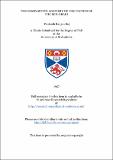Files in this item
The comparitive anatomy of the tectum of the mid-brain
Item metadata
| dc.contributor.advisor | Mulligan, John H. | |
| dc.contributor.author | Roy, Probodh Ranjan | |
| dc.coverage.spatial | 252 p. | en_US |
| dc.date.accessioned | 2018-07-06T08:50:32Z | |
| dc.date.available | 2018-07-06T08:50:32Z | |
| dc.date.issued | 1957 | |
| dc.identifier.uri | https://hdl.handle.net/10023/15026 | |
| dc.description.abstract | 1. The materials consisted of 20 Salmo salar (salmon parr), 12 Rana teroporaria (frog), 12 Lacerta viridis (Common green lizard), 45 Gallus domesticus (domestic fowl), and 20 Mus norvegious albinus (common white rat). 2. The brains, having been fixed by injection with 10% neutral formol-saline, were carefully dissected out. Some measurements and photographs were made, and the specimens were embedded in paraffin outing down the time of dehydration in the higher grades of alcohol to a minimum and avoiding cedar-wood oil as a clearing agent for reasons which have been given in the text. Three series of serial sections, out at 15?, were prepared from each brain embedded, and were respectively, (a) impregnated with silver by the Bodian Method, (b) stained with, carbol fuohsin and (c) stained with iron haematoxylin. One hundred and two such series were prepared. 3. The following conclusions were reached: (a) The size of the optic lobes, as observed from the surface and relative to the size of the cerebrum, was found to diminish as the vertebrate series of brains was ascended. Estimations of the volume of the optic lobes were, however, not made. (b) It was verified that the superior and the inferior colliculi of the mammals are homologous respectively with the optic tectum and the torus semi-circularis composing the sub mammalian optic lobe. Further, it was found that structurally the optic lobes (in: eluding the ventricles) of the pieces, amphibia and reptilia, and the tectum of the mammalia could be arranged in this order as a series. The optic lobes of the aves were, however, divergent, in that they could not be placed in the series as an intermediate stage between the reptilian and mammalian forms. (c) Throughout the vertebrate series the optic tectum including the superior colliculus of mammals presents a lamination of its constituent cells and fibres. The layers of the representative brains were numbered from without inwards and were compared and correlated with each other using Huber and Crosby's classification of the layers in the reptilian optic tectum as a standard. The lamination of the optic tectum at first increases as the vertebrate series is ascended; it reaches its peak development in the lizard and the bird, and undergoes a reduction again in the mammals. (d) Homologies in the structure of the torus semi-circular is of the lower vertebrates, the nucleus mesencephalicus lateralis pars dorsalis of the aves and the inferior colliculus of the Mammalia were noted. (e) The morphology of the torus longitudinalis, conspicuous in the teleostean fish, was examined. The torus is formed by the fusion in the median plane of two separate processes, from the dorso-medial part of the optic tectum all the layers of which take part in its formation. | en_US |
| dc.language.iso | en | en_US |
| dc.publisher | University of St Andrews | |
| dc.subject.lcc | QL933.R7 | |
| dc.subject.lcsh | Nervous system | en |
| dc.title | The comparitive anatomy of the tectum of the mid-brain | en_US |
| dc.type | Thesis | en_US |
| dc.type.qualificationlevel | Doctoral | en_US |
| dc.type.qualificationname | PhD Doctor of Philosophy | en_US |
| dc.publisher.institution | The University of St Andrews | en_US |
This item appears in the following Collection(s)
Items in the St Andrews Research Repository are protected by copyright, with all rights reserved, unless otherwise indicated.

